The thing I can't see or understand from the picture is what all prevents the towers from tipping laterally to the stage. It doesn't seem like there's anything tying them off to each other outside of the center point and the guying down to the edge of their bases which seems like a pretty steep angle compared to the truss towers. Outside of the sliding, it looks like it'd be pretty tippy without anything tied off from the grid.
You are using an out of date browser. It may not display this or other websites correctly.
You should upgrade or use an alternative browser.
You should upgrade or use an alternative browser.
Ed Sheeran cancels in Vegas
- Thread startergafftaper
- Start date
Malabaristo
Well-Known Member
It is hard to see, but it looks like there are two lines from the top of each tower forming a triangle of support.The thing I can't see or understand from the picture is what all prevents the towers from tipping laterally to the stage. It doesn't seem like there's anything tying them off to each other outside of the center point and the guying down to the edge of their bases which seems like a pretty steep angle compared to the truss towers. Outside of the sliding, it looks like it'd be pretty tippy without anything tied off from the grid.
I too would be really interested in learning what the design process was that lead them to believe floor friction would be reliable enough to resist those forces in all cases. It just seems like such a wildly variable thing with even the same floor possibly having significantly different performance on different days depending on how it was last cleaned/polished/etc.
Found a timelapse of the build-
Those large guitar picks present in the position they're shown in. They're double-sided video walls.BTW, Are those triangle things supposed to mate up with the top of the truss so they look like big Lacrosse stick's?
So each of those sticks has the guitar pick video walls, light fixtures, additional LED panels, and PA system hanging on them, plus they support the center PA hangs and the center-stage video screen and lighting. The rig is entirely ground-supported from the perimeter sticks.
I would actually be very interested in seeing a simulation of what would a failure here would look like from an academic point of view because of how interconnected the network of loads is. Since the ballast would slide with the towers, I could see how it might just cause the center-hung equipment to droop and go off-kilter. I'd be curious if there's any reasonable scenario that would lead to a cascading failure of all of the towers. Someone should bug Grady on Practical Engineering to do a video on it.
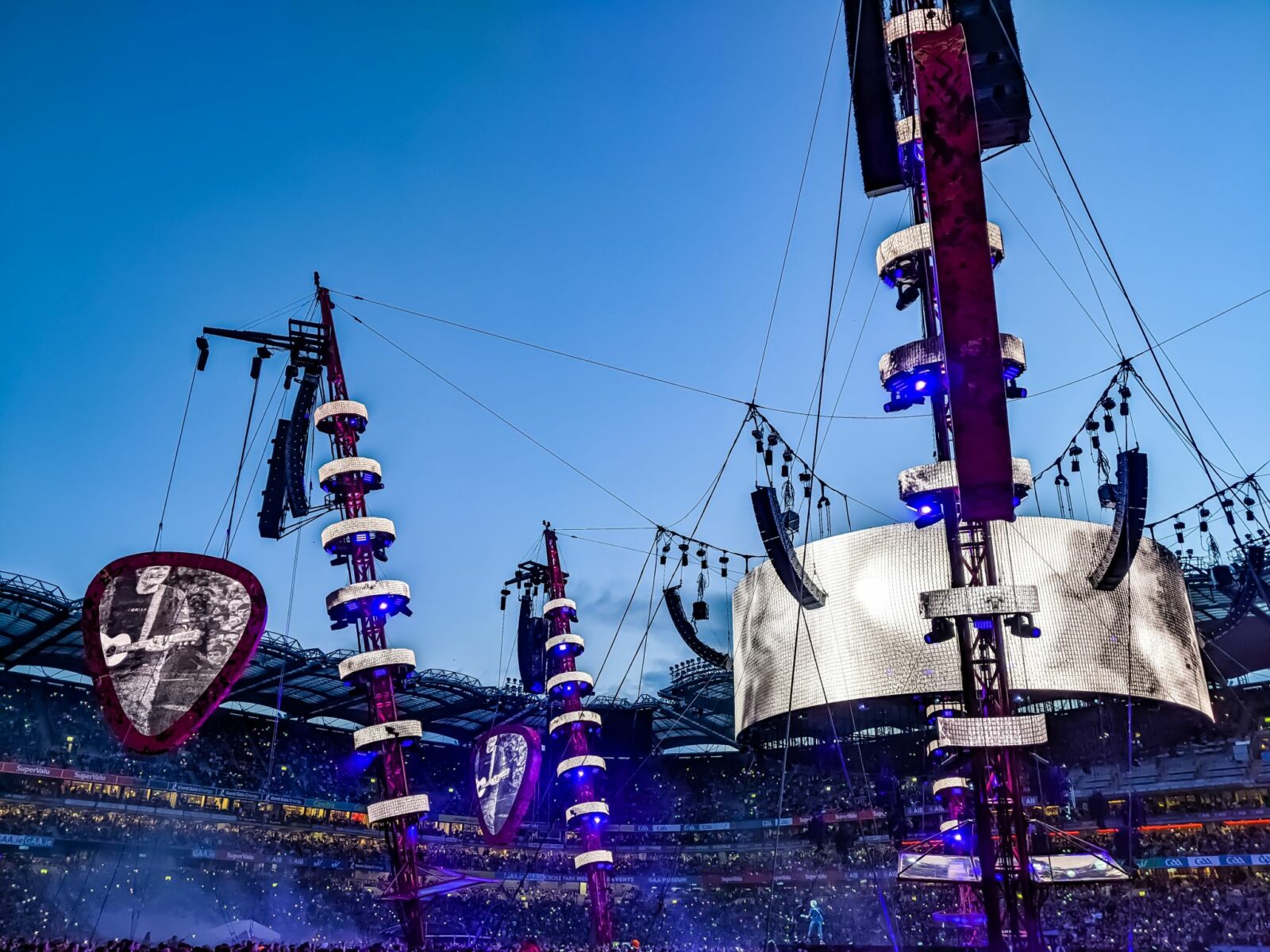
Ed Sheeran +–=÷× Tour | Stage One
High spec engineering and manufacturing of six steel 30m tall truss and a free standing cable net, for an international music icon's tour.
I kind of thought that too at first, but given the ballasts are supported on the same structure as the towers, seems like if the towers/ballasts start sliding in toward the stage, it would shift the load balance, maybe cause the center-hung PA and screen to droop. So long as it happens gradually and doesn't reach an extreme, I tend to think it would all stay upright -- just that everything center-hung would hang a little lower or out-of-plumb. Seems like the cables from the center-hangs as well as to the ballast structures would all remain in a reasonable degree of tension and avoid reaching a critical threshold. For things to get really scary, it might take an instantaneous movement of the towers by several inches to start an oscillation in the load balancing that could lead to the kind of cascading failure you mention.You can see in the video that they install a support to hold the towers upright until the steel "web" is complete. I'd guess a single point failure means that whole thing is in trouble.
That's why I think it would be really interesting to see a simulation of what kind of failures would be "sub-optimal" versus "catastrophic" -- because if you did for any reason actually lose one tower, it has potential to be one of the worst mass casualties in the industry and bring the entire rig down -- over the stage, over the crowd on the ground floor, and into the stadium seating. But, it may be pretty extraordinary what would have to happen to reach that critical threshold into catastrophic failure.
In any case, it's a very intriguing structural design concept in spite of these issues in Vegas.
It's hard to see from any of the angles how interconnected any of the towers actually are. I'm guessing there's something we're not seeing the whole picture of, but I agree it would be really neat to examine. The show ran for a long time without any issues this big.
The link Ethan posted has very clear photos.It's hard to see from any of the angles how interconnected any of the towers actually are. I'm guessing there's something we're not seeing the whole picture of, but I agree it would be really neat to examine. The show ran for a long time without any issues this big.
Aside from the loads supported by the towers for the speakers and screens, they each have two cables down to the ballast structures and two cables out towards the central structural net over the stage. Each corner of the central net is supported by two towers.
There are additional cables from the central net that tie back to the bases of the towers as guy wires.
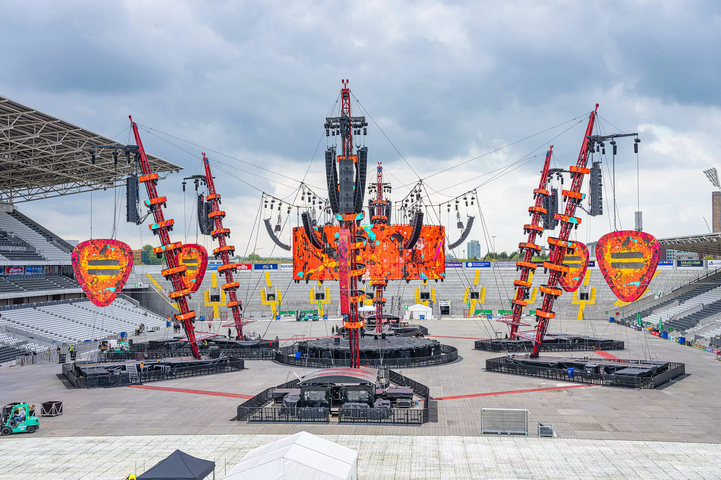
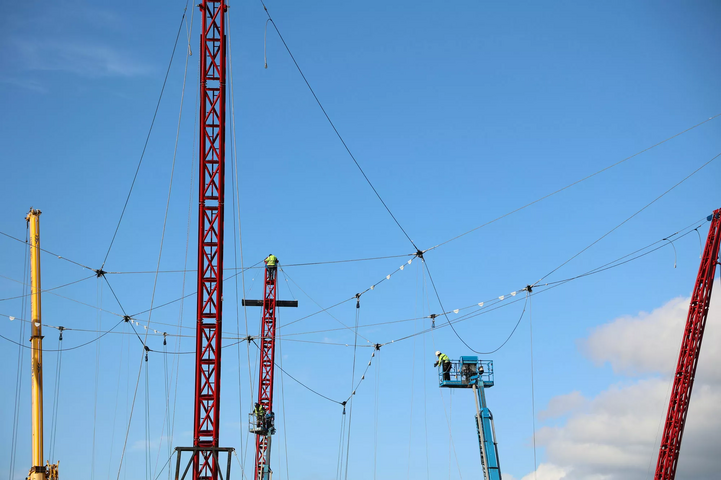
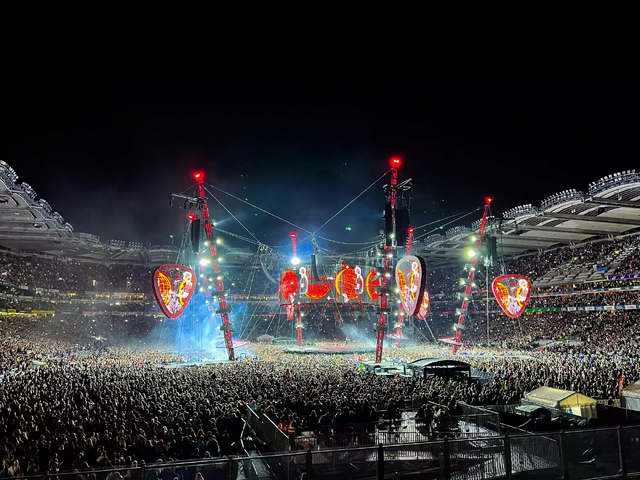
Jay Ashworth
Well-Known Member
What Rigger?
I'm so fly....I Neverland.
Ask and Diamond Dave shall explain:
DLR explains the brown M&M's
Jay Ashworth
Well-Known Member
A more in-depth -- and slightly different -- rendering than he provided in his auto-biography _Crazy from the Heat_.
IIRC, The Smoking Gun got their hands on one of those 26-page riders, cause I remember seeing it. Lessee...
Yup; here it is. *53* pages long. And as I remembered, the M&M clause is not randomly located; it's in with all the other munchies -- in my opinion a *much* better place to put it for the purpose they intended.
Enjoy:
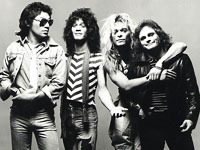
Van Halen's Legendary M&M's Rider
DECEMBER 11--Behold the Holy Grail. Since we began publishing backstage concert riders about 10 years ago, TSG has been searching for the most famous rider of them all, the one in which Van Halen famo
techieman33
Well-Known Member
A more in-depth -- and slightly different -- rendering than he provided in his auto-biography _Crazy from the Heat_.
IIRC, The Smoking Gun got their hands on one of those 26-page riders, cause I remember seeing it. Lessee...
Yup; here it is. *53* pages long. And as I remembered, the M&M clause is not randomly located; it's in with all the other munchies -- in my opinion a *much* better place to put it for the purpose they intended.
Enjoy:

Van Halen's Legendary M&M's Rider
DECEMBER 11--Behold the Holy Grail. Since we began publishing backstage concert riders about 10 years ago, TSG has been searching for the most famous rider of them all, the one in which Van Halen famowww.thesmokinggun.com
This has never made any sense to me. Just one of those stories that was made up to try and keep the band from looking like a bunch of tools. As a production guy I’m not going to pay any attention to the catering section of the rider. Maybe a quick glance to make sure they don’t need a bunch of power, but I couldn’t care less about what kind of food they want in catering or for their bus stock. If they wanted to make sure someone in the production team read the rider they should have put something weird in that section of it.
Jay Ashworth
Well-Known Member
Yup; you missed it.This has never made any sense to me. Just one of those stories that was made up to try and keep the band from looking like a bunch of tools. As a production guy I’m not going to pay any attention to the catering section of the rider. Maybe a quick glance to make sure they don’t need a bunch of power, but I couldn’t care less about what kind of food they want in catering or for their bus stock. If they wanted to make sure someone in the production team read the rider they should have put something weird in that section of it.
As explained, this was a mine-canary, to see if the purchaser read *every single line of the rider* -- you can't guarantee that they executed correctly even if they *did* read it all, but it's pretty certain they won't if they didn't.
And if you're touring 40 tons of staging into venues without experience at that, you want to know early if you need to reinspect everything.
Among Dave Roth's other professions, he's an EMT -- I've seen the ID card -- so it doesn't surprise me that his band would have thought this far ahead for patron safety.
Based on the item that started this thread, it looks like maybe we've forgotten that.
In short: they didn't care if *you* read it in the rider: they cared if the people one and two layers up above you did.
techieman33
Well-Known Member
My point is that the purchaser isn’t going to be the one making sure that everything was setup to meet the rider specs. They’re going to be asking department heads if they see any problems with the rider. And then leaving them to take care of it of their own departments. In the 20 years I have been doing this I have never seen a promoter or building executive checking to make sure the rigging was safe, or that the catering provided perfectly matched the rider. They’re not going to get involved with the nuts and bolts unless a department head or the tour brings a problem to their attention. The tour seeing that catering was setup correctly might be a good sign that the venue has their ducks in a row, but it’s not a guarantee. Just because one department got it right doesn’t mean the others did.Yup; you missed it.
As explained, this was a mine-canary, to see if the purchaser read *every single line of the rider* -- you can't guarantee that they executed correctly even if they *did* read it all, but it's pretty certain they won't if they didn't.
And if you're touring 40 tons of staging into venues without experience at that, you want to know early if you need to reinspect everything.
Among Dave Roth's other professions, he's an EMT -- I've seen the ID card -- so it doesn't surprise me that his band would have thought this far ahead for patron safety.
Based on the item that started this thread, it looks like maybe we've forgotten that.
In short: they didn't care if *you* read it in the rider: they cared if the people one and two layers up above you did.
Ultimately it's the promoter's legal responsibility to fulfill the riders, so you can bet your ass a promoter representative reviews EVERY page (these days). Whether or not they act on what they read is another matter, and I got stories....My point is that the purchaser isn’t going to be the one making sure that everything was setup to meet the rider specs. They’re going to be asking department heads if they see any problems with the rider. And then leaving them to take care of it of their own departments. In the 20 years I have been doing this I have never seen a promoter or building executive checking to make sure the rigging was safe, or that the catering provided perfectly matched the rider. They’re not going to get involved with the nuts and bolts unless a department head or the tour brings a problem to their attention. The tour seeing that catering was setup correctly might be a good sign that the venue has their ducks in a row, but it’s not a guarantee. Just because one department got it right doesn’t mean the others did.
Similar threads
- Replies
- 19
- Views
- 1K
- Replies
- 8
- Views
- 2K
- Replies
- 9
- Views
- 559
- Replies
- 2
- Views
- 786
Users who are viewing this thread
Total: 1 (members: 0, guests: 1)


